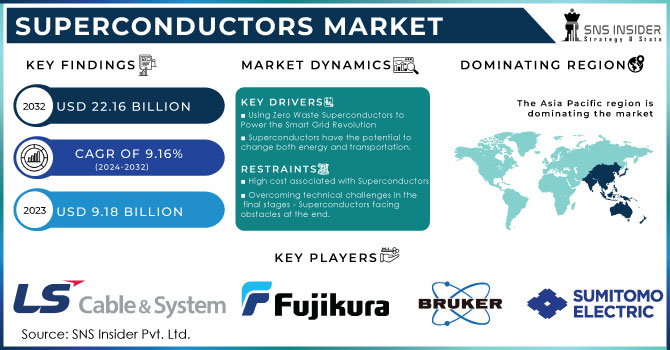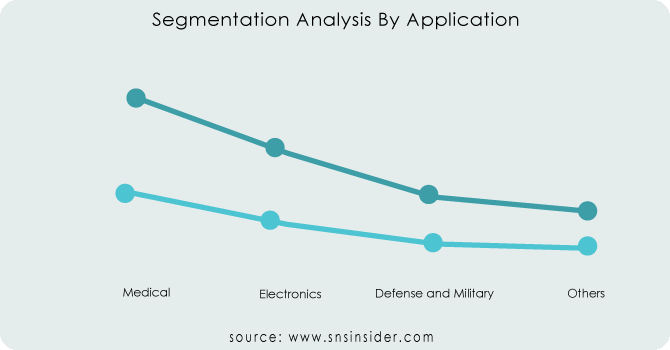Superconductors Market Report Scope and Overview:
The Superconductors Market was Valued at USD 10.94 Billion in 2025E and is now anticipated to grow to USD 22.05 Billion by 2033, displaying a compound annual growth rate (CAGR) 9.16% of during the forecast Period 2026 - 2033.
Superconductors Market have great potential to transform transportation, especially with the use of maglev trains. These trains without friction use superconductors to reach high speeds while being environmentally friendly. Developments in materials with elevated critical temperatures and the invention of maglev technology may result in a broad acceptance, generating a lucrative market potential for superconductors in transportation. These developments will also necessitate less complex and more affordable cooling systems, like cryogen-free choices, further boosting hope for widespread adoption.
Even though there were difficulties at first, such as grain boundary issues in ceramic superconductors, progress in manufacturing technologies has led to the production of higher quality materials. Superconductor technology provides a special combination of electrical, mechanical, and thermal regulation, enabling the development of power components with significantly higher current capacities (100 times greater than copper) than conventional materials. This results in higher efficiency, increased power densities, smaller weight and size, better resolutions, and incredibly fast speeds. Superconductors present a better answer for various uses, offering distinct features and excellent effectiveness that make them the top choice for overcoming technical challenges and promoting environmentally friendly efforts.
Superconductors Market t Size and Forecast:
-
Market Size in 2025E: USD 10.94 Billion
-
Market Size by 2033: USD 22.05 Billion
-
CAGR: 9.16% from 2026 to 2033
-
Base Year: 2025E
-
Forecast Period: 2026–2033
-
Historical Data: 2022–2024
Superconductors Market Highlights:
-
Using zero waste superconductors can reduce power transmission losses, save energy costs, and support the development of smart grids for more efficient and sustainable electrical infrastructure.
-
Superconductors enable new applications in transportation such as maglev trains, offering high-speed, eco-friendly travel, and can play a key role in fusion energy by containing plasma in reactors.
-
They enhance performance in electric motors, generators, and renewable energy systems like wind power due to minimal energy dissipation and high efficiency.
-
High production and cryogenic cooling costs make superconductors expensive, limiting adoption in organizations with budget constraints and increasing overall deployment complexity.
-
Technical challenges include limited current density and difficulties in manufacturing long superconductor wires, restricting large-scale implementation in power grids and transportation systems.
-
Continuous research and advancements in materials, manufacturing, and cooling technologies are essential to unlock the full potential of superconductors across energy, transportation, and industrial applications.

Get More Information on Superconductors Market - Request Sample Report
Superconductors Market Drivers:
- Using Zero Waste Superconductors to Power the Smart Grid Revolution
With the rise in global energy demands, reducing power transmission losses emerges as a significant challenge. This is when superconducting materials come into play, providing a fresh solution. These special materials exhibit almost no electrical resistance, leading to significantly reduced energy loss in transmission. This leads to a dual advantage energy providers save money significantly and there is a decreased environmental impact by cutting down on wasted electricity. This is best suited for the growing smart grid initiative. Smart grids aim to create a more efficient and intelligent power system, and superconductors are perfect for achieving this objective. Smart grids can enhance reliability and decrease energy loss by substituting regular wires with superconductors. Picturing electricity moving through power lines with minimal loss is what future superconductors offer, paving the way for a more sustainable and efficient electrical infrastructure.
- Superconductors have the potential to change both energy and transportation.
Superconductors are expected to have effects beyond just the power system. Their ability to transmit electricity with minimal impedance allows for a variety of new potential uses. Picture trains smoothly moving on tracks, maglev trains powered by superconductors offer just that. These advanced vehicles provide rapid speed and environmentally friendly adaptability, potentially revolutionizing transportation. During the construction phase, it is crucial to have advancements in high-temperature superconductors in order to actualize these trains. Superconductors also possess the key to a sustainable, almost limitless energy Type fusion power. Superconductors are crucial in this clean energy method because they hold high levels of plasma in fusion reactors. Research is ongoing to develop high-temperature superconductors, representing a significant step in making fusion a viable energy option. Superconductors have a much wider influence. This technology will provide advantages for high performance motors and generators. Superconductors Market could potentially revolutionize several sectors by enabling more efficient electric vehicles and boosting wind power generation due to their minimal energy dissipation and superior effectiveness. This glimpse into the future of superconductivity shows a technology that could revolutionize transportation, energy production, and more.
Superconductors Market Restraints:
- High cost associated with Superconductors
Superconductors indicate strong dedication, yet they encounter a significant cost limitation. Producing these incredible materials and their complex cryogenic cooling systems is a costly process. This significant upfront cost serves as a major obstacle for prospective clients, especially within organizations lacking adequate funds. Imagine a power plant that charges a premium solely for reducing energy waste, the expensive price tag may be difficult & cost persists thereafter. Cooling systems needed for superconducting materials to function properly introduce an additional level of complexity. Working in hazardous environments, these systems require specific tools and expertise for maintenance, increasing deployment costs. The high price hinders widespread use, particularly in industries with tight budgets. Overcoming the financial obstacle is crucial for superconductors to realize their groundbreaking potential. Improvements in manufacturing techniques, finding cheaper materials, and enhancements in freezing technology are crucial in making superconducting materials more financially viable for a wider range of uses.
- Overcoming technical challenges in the final stages - Superconductors facing obstacles at the end.
While there are many technological obstacles hindering superconductors from reaching their maximum potential, they seem to be moving towards greatness. The amount of electrical current they can handle is a major challenge due to their current density. Imagine a car powered by electromagnetism. Inefficiencies and bottlenecks arise when traffic volume is limited. The restricted current density of superconductors also restricts their potential uses. Another challenge is making long superconductor wires. The production of these cables over long distances is currently still unachievable. Think about constructing a power grid with superconductor technology. When the cables are restricted in length, the entire system becomes divided and unattainable. To overcome these constraints and create intricate, high-current density superconductor cables, specialists are continuously developing new techniques. Technical challenges indicate the need for further research and enhancement. Superconductors could make a groundbreaking impact if they manage to address limitations in current density and wire advancement. The potential of this technology allows for the integration of superconductors into power grids, medical devices, and transportation systems in the future. Continuous progress is necessary to unlock this potential.
Superconductors Market Segment Analysis:
By Type
Low-temperature superconductors dominate the superconductor market with a significant 50% market share IN 2025. Their superior position is rooted in a three-sided benefit. Initially, established manufacturing methods help lower production expenses and ensure easily accessible materials, making low temperature superconductors a more cost-effective choice in comparison to high temperature superconductors. Next, low temperature superconductors have a successful history. They are the reliable engines driving high-field MRI machines, essential instruments in medical diagnostics. This tale of triumph has solidified their standing in the market. In conclusion, although high temperature superconductors offer the potential to work at elevated temperatures, low temperature superconductors are currently more effective in terms of current density. They are able to manage higher electrical currents without losing their superconductivity, leading to increased efficiency in particular uses. Nevertheless, the fate of superconductors is not set in stone. Developing better high temperature superconductor’s technology continues to present a major challenge to the dominant position of low temperature superconductors. With increased commercial viability, high temperature superconductors have the capacity to shake up the market and overthrow low temperature superconductors as the dominant player.
By Application
With a dominant position, the Medical sector holds 35% of the market share in 2025 , making it the clear leader. This power is established on a solid base & vital component of MRI machines, a dependable technology used to diagnose various medical conditions. With the increasing need for advanced diagnostics, there is a corresponding growth in this particular sector. Demonstrate a successful history in medical uses. The medical field relies on their trustworthiness and safety in MRI machines, solidifying them as the preferred option for this crucial technology. Although areas like electronics, defense, and military applications show potential for superconductors, they are still in their early stages. Having a well-known and reliable position in the medical industry provides the medical sector with a distinct edge, strengthening its position as a leader in the superconductor market.

Need any customization research on Superconductors Market - Enquiry Now
Superconductors Market Regional Analysis:
Asia-Pacific Superconductors Market Trends:
Asia Pacific Dominates the worldwide superconductor market, with a large 40% share in 2025 . This supremacy originates from a potent blend of elements. The strong economic growth in countries like China and India is driving the need for sophisticated technologies such as superconductors in the area. These innovative materials are being incorporated into vital sectors such as transportation, healthcare (for example, MRI machines), and electricity networks - all critical for economic and social progress. Governments in the Asia Pacific region are actively encouraging the use of superconductors through laws and programs, acknowledging the advantages they offer. In conclusion, the area's significant emphasis on enhancing infrastructure, particularly smart grids, provides an ideal setting for the incorporation of superconductors. Smart grids prioritize energy efficiency and are perfectly suited for superconductors due to their almost nonexistent resistance. This supremacy isn't only due to current directions; it is set to keep driving the worldwide superconductor industry in the future. Analysts anticipate substantial expansion in the Asia-Pacific area, propelled by two main factors: large investments in power grid improvement and the region's increasing utilization of renewable energy sources.
The renewable energy initiative in Asia Pacific is also a significant motivator. Efforts such as Japan's 6th Strategic Energy Plan and Singapore's aim to bring in 4GW of low-carbon electricity by 2035 demonstrate this dedication. These plans require a strong infrastructure to transmit renewable energy, and superconducting cables and devices are the ideal answer. In addition to power grids, there has been a notable increase in the need for superconducting materials in the Asia-Pacific region. The increase is mainly fueled by the thriving electronics sector, especially in China and India. Positive governmental regulations are driving expansion within this industry. In the electronics manufacturing industry, China saw an impressive 38.9% increase in profits in 2021, while India reached a consumer electronics production worth INR 705 billion. Increased growth in the Asia Pacific healthcare industry is fueling a higher need for superconductors. India's expenditure in the health sector increased by nearly 73% between 2020 and 2021.This increase in funding results in a demand for advanced medical equipment, including the frequent utilization of superconductors like MRI machines.
North America Superconductors Market Trends:
North America holds a 30% portion of the superconductor market in 2025. Despite not currently being at the forefront, this individual has the potential to become a significant figure in the future. North America is focused on advancing superconductor technology through innovation and extensive investment in research and development. They have definitely earned their reputation for adopting cutting-edge innovations quickly. Superconductors can be readily incorporated due to their innovative mindset and robust infrastructure. The USA holds a significant portion of the superconductor market thanks to its robust research and development capabilities, advanced technological infrastructure, and various applications in sectors like healthcare, energy, and transportation, leading to increased demand for superconducting materials and equipment in the country. The presence of well-known companies and universities engaged in superconducting R&D boosts the market influence of the United States.
Europe Superconductors Market Trends:
Europe is a significant player in the race for superconductors. This region boasts a strong history of technological progress, indicating promising potential in the superconductor sector. Several prominent companies in Europe are at the forefront of developing and producing superconductor technology. Their established presence in the market provides them with a substantial edge over their rivals.
Latin America Superconductors Market Trends:
Latin America has the potential to emerge as a major contender. This possibility arises from a combination of different factors. There is an increasing need for energy in the region, and superconductors provide a revolutionary solution by reducing energy loss during transmission. This major benefit could play a pivotal role in driving the future uptake of superconductor technology. Moreover, as superconductors become cheaper and more widely available, South America may become a more appealing market for their use
Middle East & Africa Superconductors Market Trends:
Middle East & Africa lags in the superconductor market, but there is potential for growth ahead. At present, its occurrence is minimal in comparison to regions such as this can be attributed to two main factors. To begin with, numerous countries in the Middle East and Africa are still in the process of development, prioritizing basic needs over advanced technologies like superconductors.

Superconductors Market Key Players:
-
LS Cable & System Ltd.
-
Bruker Corporation
-
Fujikura Ltd.
-
Sumitomo Electric Industries, Ltd.
-
Furukawa Electric Co., Ltd.
-
American Superconductor Corporation
-
Japan Superconductor Technology Inc.
-
Hyper Tech Research, Inc.
-
Hitachi Ltd.
-
Cryomagnetics Inc.
-
Siemens AG
-
evico GmbH
-
Metal Oxide Technologies, Inc.
-
Theva Dünnschichttechnik GmbH
-
SuperOx
-
Western Superconducting Technologies Co., Ltd.
-
Southwire Company, LLC
-
Nexans SA
-
Tokamak Energy Ltd.
-
Superconductor Materials, Inc.
Superconductors Market Competitive Landscape:
LS Group is a South Korea–based industrial conglomerate established in 1936, specializing in electricity, energy, materials, and automation solutions. Spun off from LG in 2003, it operates globally through subsidiaries such as LS Cable & System and LS Electric, with a strong focus on power transmission, smart grids, and advanced electrification technologies.
- In July 2025, LS Group, in partnership with KEPCO, announced plans to build the world’s first superconducting power grid at a hyperscale data center in Gapyeong, South Korea, targeting completion by 2028.
Nexans SA is a France-based global leader in advanced cable and electrification solutions, established in 1897. The company designs and manufactures power, data, and superconducting cables for energy, infrastructure, industrial, and digital applications, supporting sustainable electrification, smart grids, and next-generation data center power systems worldwide.
- In November 2025, Nexans SA highlighted the role of superconducting power cables in enabling gigawatt-scale, AI-driven data centers, addressing space, heat, and efficiency constraints of conventional copper systems.
| Report Attributes | Details |
|---|---|
| Market Size in 2025E | USD 10.94 Billion |
| Market Size by 2033 | USD 22.05 Billion |
| CAGR | CAGR of 9.16% From 2026 to 2033 |
| Base Year | 2025E |
| Forecast Period | 2026-2033 |
| Historical Data | 2022-2024 |
| Report Scope & Coverage | Market Size, Segments Analysis, Competitive Landscape, Regional Analysis, DROC & SWOT Analysis, Forecast Outlook |
| Key Segments | • By Type (Low Temperature, High Temperature) • By Application (Medical, Electronics, Defense and Military, Others) |
| Regional Analysis/Coverage | North America (US, Canada), Europe (Germany, UK, France, Italy, Spain, Russia, Poland, Rest of Europe), Asia Pacific (China, India, Japan, South Korea, Australia, ASEAN Countries, Rest of Asia Pacific), Middle East & Africa (UAE, Saudi Arabia, Qatar, South Africa, Rest of Middle East & Africa), Latin America (Brazil, Argentina, Mexico, Colombia, Rest of Latin America). |
| Company Profiles | LS Cable & System Ltd., Bruker Corporation, Fujikura Ltd., Sumitomo Electric Industries, Ltd., Furukawa Electric Co., Ltd., American Superconductor Corporation, Japan Superconductor Technology Inc., Hyper Tech Research, Inc., Hitachi Ltd., Cryomagnetics Inc., Siemens AG, evico GmbH, Metal Oxide Technologies, Inc., Theva Dünnschichttechnik GmbH, SuperOx, Western Superconducting Technologies Co., Ltd., Southwire Company, LLC, Nexans SA, Tokamak Energy Ltd., and Superconductor Materials, Inc. |

